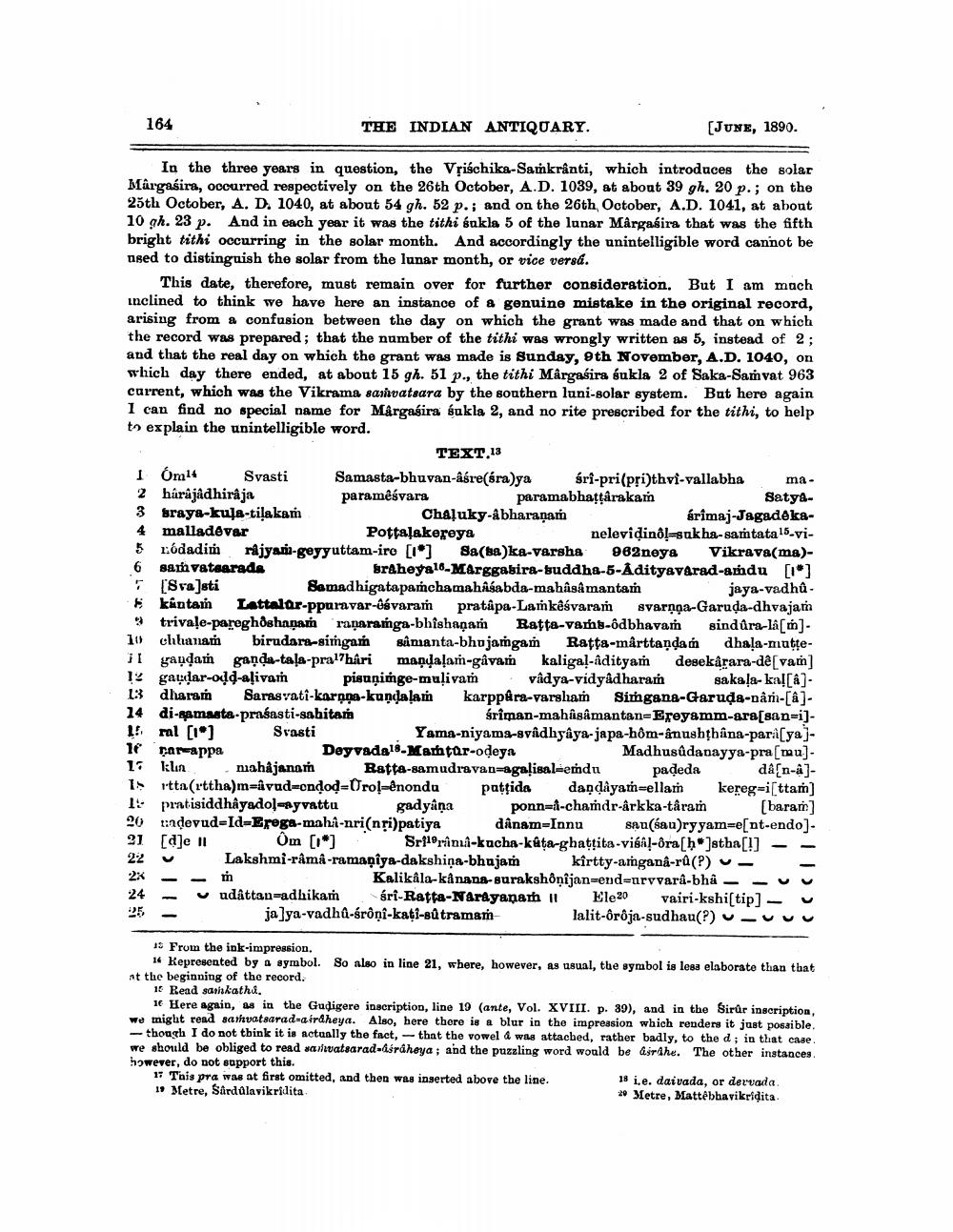________________
164
THE INDIAN ANTIQUARY.
(JUNE, 1890.
In the three years in question, the Vrischika-Sankranti, which introduces the solar Märgaśira, occurred respectively on the 26th October, A.D. 1039, at about 39 gh. 20 p.; on the 25th October, A. D. 1040, at about 54 gh. 52 p.; and on the 26th October, A.D. 1041, at about 10 gh. 23 p. And in each year it was the tithi śnkla 5 of the lunar Márgasira that was the fifth bright tithi oocurring in the solar month. And accordingly the unintelligible word cannot be used to distinguish the solar from the lunar month, or vice versa.
This date, therefore, must remain over for further consideration. But I am mach inclined to think we have here an instance of a genuine mistake in the original record, arising from a confusion between the day on which the grant was made and that on which the record was prepared ; that the number of the tithi was wrongly written as 5, instead of 2; and that the real day on which the grant was made is Sunday, 9th November, A.D. 1040, on which day there ended, at about 15 gh. 51 p., the tithi Mârgasira sukla 2 of Saka-Samvat 963 current, which was the Vikrama sasivatsara by the southern luni-solar system. But here again I can find no special name for Margasira sukla 2, and no rite prescribed for the tithi, to help to explain the unintelligible word.
TEXT.13 IÓna14 Svasti Samasta-bhuvan-âśre(sra)ya sri-pri(pri)thvi-vallabha ma2 hárâjâdhiraja
paramêśvara paramabhattarakan
Saty&3 sraya-kula-tilakam
Chaļuky-abharanam
srimaj-Jagadeka4 malladevar Pottalakereya
nelevidinol-sukha-samtata 15-vi5 rodadi rjyan-geyyuttam-iro [1] Sa(ka)ka-varsha 962neya Vikrava(ma)6 san vataarada
Sr&heya16-MArggabira-buddha-5-Adityavarad-andu [1] [Sva]sti SamadhigatapamchamahAsabda-mahasAmantan
jaya-vadhû. kántan Lattalar-pparavar-ośvaram pratâpa-Lankêśvaram svarnoa-Garuda-dhvajam
triva!e-paroghdshaņam raņaraṁga-bhishaņań Ratta-vam-odbhavan sindůra-la[mn). 11) chlanan birudars-simga siimanta-bhojamgam Ratta-marttandandhala-matte11 gaudan ganda-tasa-pral7hari mandaļam-gavam kaligal-Adityam desekärara-de[vam] 12 gaudar-odd-ațiva pisuņinge-malivam vadya-vidyadharam saka!a- ka![á]13 dharam Sarasvati-karnna-kundalam karppara-varshan Singana-Garude-nam-[a]14 di-samasta-prasasti-sabitan
sriman-mahâsâmantan-Ereyamm-ara[san=i)19 ral (1) Svasti
Yama-niyama-syâdhyâya-japa-hôm-anushthana-parâ(ya)1e parappa Deyvads18. Martar-odeya
Madhusûdanayya-pra[mu) - 1: klin mahajanam Ratta-samudravan=agaļisal=endu padeda d a (n-à]1 rtta/rttha)m=avud-ondod-Urol-énonda pattida daşdayam-ellam kereg=i[ttam) 1% pratisiddhầyadol-ayvattu gadyâņa ponn=i-chaṁdr-arkka-târam (baram 20 tindevud-Id-Erega-mahi-nri(nri)patiya dânam-Innu san(sau)ryyam=e[nt-endo). [d]e 11 Om [1] Srflorina-kucha-kata-ghattita-vill-ra[h]stha[!] - -
Lakshmi-rama-ramaniya-dakshiņa-bhajan kirtty-amgana-ra(P) - - 2x - -
Kalikala-kanana-surakshônijan-end-urvvara-bhå - -uu - v udattan-adhikam s ri-Ratta-Narayanar 11 Ele20 vairi-kshi(tip) - ja ]ya-vadhû-śrôni-kati-sūtraman
lalit-ôroja-sudhau(?) ucuvu
19 From the ink-impression.
16 Kepresented by a symbol. So also in line 21, where, however, as usual, the symbol is less elaborate than that at the beginning of the record.
16 Read sankathi.
16 Here again, as in the Gudigere inscription, line 19 (ante, Vol. XVIII. p. 89), and in the Birur inscription, we night read sarhvatsarad-airdheya. Also, here there is a blur in the impression which renders it just possible.
- though I do not think it is actually the fret, -that the vowel & wils attached, rather badly, to the d; in that case we should be obliged to read awatarad.Ardhaya; and the puzzling word would be air the. The other instances however, do not support this. 11 Tois pra was at first omitted, and then was inserted above the line.
18 i.e. daivada, or dervada. 11 Metre, Sardúlavikridita
20 Metre, Mattēbhavikridita




